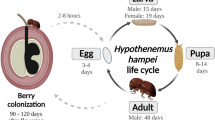Abstract
The European corn borer (ECB), Ostrinia nubilalis (Hΰbner) (Lepidoptera: Crambidae), is the major arthropod pest of corn in Croatia. However, chemical control is carried out only in maize for seed production, and in sweet corn. A 3-year investigation was carried out in corn fields in northwest Croatia to establish the most attractive pheromone lure for ECB monitoring, the optimal timing of insecticide applications, and the efficacy of selected insecticides against ECB. During each of the 3 years, the pheromone lures E, Z and E/Z («Isagro») were evaluated in the field from May to July. Insecticides were sprayed 14–20 days after the maximal capture in 2002 and 2003. In 2004, three different trials were set up: one trial with one early treatment (when corn was in the R49 development stage according to the extended BBCH scale); one with one late treatment (when corn was in the R65 development stage according to the BBCH scale); and one with two treatments in both stages. In the trials studying Bacillus thuringiensis var. kurstaki (B.t.k.), insect growth regulators (IGR), spinosad and classical chemical insecticides were applied. Pheromone lure E was the most attractive for monitoring ECB flights throughout 2 years of investigation. Insecticide efficacy depended on application timing. The insecticides most suitable for integrated pest management (IPM) programs, including spinosad, B.t.k. and IGR, resulted in high (spinosad) to moderate (B.t.k.) efficacy. The efficacy of IGRs indicates the need for earlier application. The efficacy of chemical insecticides depended on the year and the insecticide. The organophosphate (OP) insecticides and pyrethroids gave moderate to good results; imidacloprid did not provide significant efficacy. One application of all insecticides based on proper (early) timing resulted in the same efficacy as two applications of the same insecticides.

Similar content being viewed by others
References
Abbott WS (1925) A method of computing the effectiveness of an insecticide. J Econ Entom 18:265–267
Bača F (1976) Ispitivanje sintetičkih feromona–seksualnih atraktanata–kukuruznog plamenca (Ostrinia nubilalis Hbn). Z Bilja 137(138):357–360
Bartels DW, Hutchison WD (1995) On-farm efficacy of aerially applied Bacillus thuringiensis for European corn borer (Lepidoptera: Pyralidae) and corn earworm (Lepidoptera: Noctuidae) control in sweet corn. J Econ Entom 88:380–386
Bartels DW, Hutchison WD, Udayagirl S (1997) Pheromone trap monitoring of Z-strain European corn borer (Lepidoptera: Pyralidae): optimum pheromone blend, comparison with blacklight traps, and trap number requirements. J Econ Entom 90:449–457
Bret BL, Larson LL, Schoonover JR, Sparks TC, Thompson GD (1997) Biological properties of spinosad. Down Earth 52:6–13
Danon V (1988) Kukuruzni moljac Ostrinia nubilalis Hb i mogućnosti suzbijanja. Poljoprivredne Aktualnosti 1(2):161–172
Dhadialla TS, Retnakaran A, Smagge G (2005) Insect-growth and development–disrupting insecticides. In: Lawrence IG, Kostas I, Sarjeet SG (eds) Comprehensive molecular insect science, vol 6 Elsevier, Oxford:117–137
Hađistević D (1969) Kukuruzni plamenac (Pyrausta nubilalis Hb.) u svetlu naših dosadašnjih istraživanja. Savjetovanje zaštite bilja, Zagreb:131–139
Hađistević D (1983) Ostrinia nubilalis. In: Čamprag D (ed) Priručnik izvještajne i prognozne službe zaštite poljoprivrednih kultura, Beograd, Savez društava za zaštitu bilja:222–228
Henderson CF, Tilton EW (1955) Tests with acaricides against the brow wheat mite. J Econ Entom 48:157–161
Hergula B (1930) O mortalitetu Pyrausta nubilalis Hb. Int Corn Bo Inves 3:142–147
Ivezić M, Raspudić E (1997) Intensity of attack of the corn borer (Ostrinia nubilalis Hűbner) on the territory of Baranja in the period 1971–1990. Nat Cro 6:137–142
Ivezić M, Raspudić E (2005) Ekonomski značajni štetnici kukuruza na području istočne Hrvatske. Razprave IV. Razreda SAZU, Dissertationes XLV-1:87–98
Krnajski M (1969) Osvrt na dosadašnje suzbijanje kuk uruznog plamenca Pyrausta nubilalis Hb. Savjetovanje zaštite bilja, Zagreb:143–151
Maceljski M (1984) Biotehnički insekticidi s posebnim osvrtom na feromone. Polj znan sm 67:609–618
Maceljski M (2002) Poljoprivredna entomologija. Zrinski, Čakovec, p 519
Maini S, Burgio G (1999) Ostrinia nubilalis Hb. (Lepidoptera: Pyralidae) on sweet corn, relationship between adults caught in multibaited traps and ear damages. J Appl Entom 123:179–185. doi:10.1046/j.1439-0418.1999.00331.x
Metalnikov S, Chorin V (1929) Pokusi korištenja bakterija za suzbijanje kukuruznog moljca. Inter Co Bo Invest 2:54–59
Metalnikov S, Hergula B, Strail D (1930) Pokusi korištenja bakterija protiv kukuruznog moljca. Inter Co Bo Invest 3:148–154
Musser FR, Shelton MA (2003) Bt sweet corn and selective insecticides: impact on pests and predators. J Econ Entom 96:71–80
Peterson LG, Ruberson JR, Sprenkel RK, Weeks JR, Donahoe MC, Smith RH, Swart JS, Reid DJ, Thompson GD (1997) Tracer naturalyte insect control and IPM. Down Earth 52:28–34
Rinkleff JH, Hutchison WD, Campbell CD, Bolin PC, Bartels DW (1995) Insecticide toxicity in European corn borer (Lepidoptera Pyralidae): ovicidal activity and residual mortality to neonates. J Econ Entom 88:246–253
Staus R (1994) Compendium of growth stage identification keys for mono- and dicotyledonous plants, extended BBCH scale. Ciba-Geigy AG
Trisyono A, Chippendale GM (1997) Effect of the nonsteroidal ecdysone agonist, metoxyfenozide and tebufenozide on the Eurpean Corn Borer. J Econ Entom 90:1486–1492
Vasilj Đ (2000) Biometrika i eksperimentiranje u bilinogojstvu. Hrvatsko Agronomsko Društvo, Zagreb, p 320
Author information
Authors and Affiliations
Corresponding author
Additional information
Communicated by K. J. Gorman.
Rights and permissions
About this article
Cite this article
Bažok, R., Igrc Barèiæ, J., Kos, T. et al. Monitoring and efficacy of selected insecticides for European corn borer (Ostrinia nubilalis Hubn., Lepidoptera: Crambidae) control. J Pest Sci 82, 311–319 (2009). https://doi.org/10.1007/s10340-009-0255-z
Received:
Revised:
Accepted:
Published:
Issue Date:
DOI: https://doi.org/10.1007/s10340-009-0255-z




